One of the most famous British legends is that of King Arthur and the sword in the stone, first found in Robert de Boron’s Merlin in the late 12th century. According to the various versions of the story, the sword could only be pulled out of the stone by the true king of England.
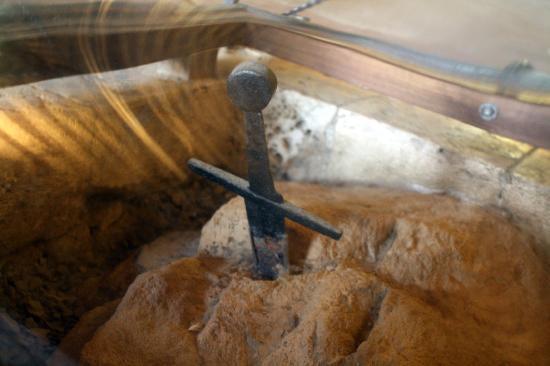
A similar, much less well-known, story of an earlier date, can be found originating from the Italian region of Tuscany. It has been suggested by some that the Italian tale was inspiration for the British legend. This is the sword in the stone of San Galgano.
Galgano Guidotti was born in 1148 in the small town of Chiusdino, Italy in the province of Siena. This strong blond boy reportedly wanted to be a knight and save the maiden. But though he became a knight, trained in the art of war, he was said to be arrogant and vicious and rather than saving the maiden, he broke many a heart. His mother Dionisia stepped in and found him a fiancée. But still he terrorized the region.
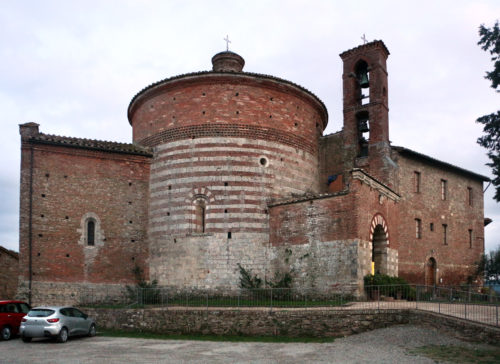
One day, Archangel Michael appeared to him, showed him the way to salvation in Montesiepi, an uninhabited ridge, near his hometown. The next day Sir Galgano announced that he was going to become a hermit and took up residence in a cave. He was reportedly ridiculed by friends and relatives for his choice. They thought he had gone mad. His mother asked him to get rid of the ragged clothes, dress as befitted his station and, at least, go and say goodbye to his fiancée, perhaps thinking he would change his mind once he had seen the maiden again.
Being an obedient Italian son, he complied. Along the way, his horse threw him and Archangel Michael stepped in again and raised him up, directing his feet back to Montesiepi. The archangel directed his gaze to the top of the hill where he saw a vision of a round temple with Jesus and Mary surrounded by the Apostles; then the angel told him to climb the hill and the vision faded. When he reached the top, Archangel Michael bade him to renounce worldly pleasures.
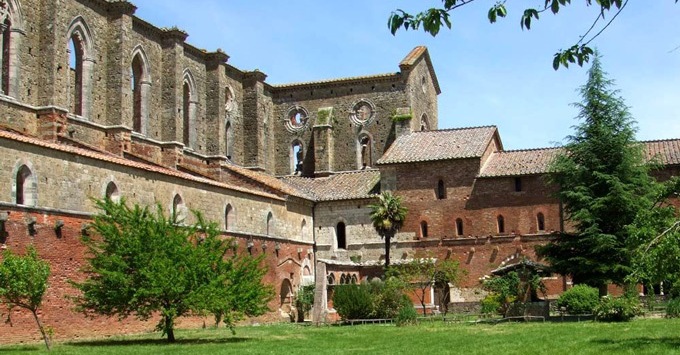
Galgano stated that giving up his riches and his fiancée would be as hard as splitting a rock, illustrating his point by attempting to plunge his sword into a large stone. The sword reported slid through the solid rock, where it remains today in the Rotonda di Montesiepi.
Another version of the story is that Galgano was convinced that his vision deserved a symbolic act; he decided to plant a cross. Since he had no way to make one of wood, he planted his sword in the ground. The earth solidified into stone and the sword could not be removed.
Galgano never left the hill again. Locals and visitors said that he lived in poverty, accompanied by wild animals, as well as the local farmers, who came to talk and ask his blessing. Others came to be followers of Galgano as religious monks. One day an assassin, disguised as a monk (some say he was sent by the Devil) came to kill Galgano; the wolves that lived with Galgano killed the man and gnawed at his bones. We know this because the bones of the murderous soul lie in a reliquary near the tomb of Galgano.
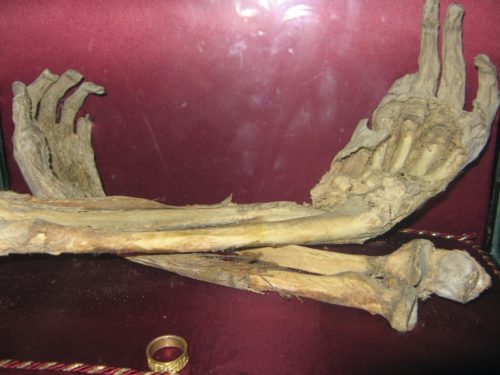
One year later, after the attempted killing, Galgano the Religious Hermit died (1181). The funeral was reportedly attended by bishops and three Cistercian abbots. The next year the Bishop of Volterra gave Montesiepi to the Cistercian monks to build a shrine to Galgano’s memory. They began building in 1185, erecting a beautifully unique round temple (Rotonda di Montesiepi) over the purported tomb (also where Galgano’s hermit’s hut was located) and where the sword remained in the stone. (Most of Galgano’s monkish followers in life left, scattered over Tuscany, becoming Augustinian hermits.) The Rotonda di Montesiepi can be visited today.
San Galgano is reported to be the first saint whose canonization was conducted through a formal process by the Catholic Church. Consequently, much of San Galgano’s life is known through the documents of his canonization, which was carried out in 1185, just a few years after his death. Nineteen miracles were recorded as part of the canonization process.
After Galgano’s death his scalp reportedly continued to grow blond curls to the amazement of the faithful. The miraculous head was placed in a reliquary in a side chapel, and the chewed bones of the arms of the assassin in another. The crowds of pilgrims who came, hoping for more miracles or to be healed of some malady, were so numerous that the Cistercians were authorized to build another monastery, named after San Galgano, a short distance away.
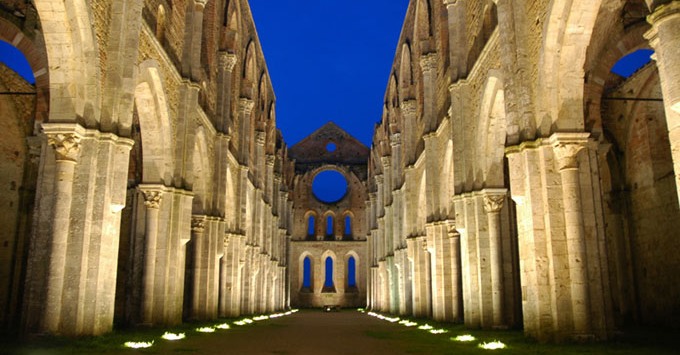
By 1220 a large Cistercian abbey was built below Galgano’s hermitage. This sect claimed him as a Cistercian saint. It was one of the most beautiful Gothic buildings of Italy. The monastery became powerful, with monks from San Galgano appointed to high offices throughout Tuscany, becoming absentee caretakers of the monastery and temple.
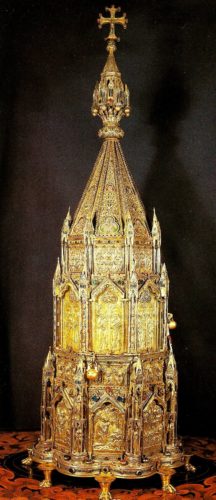
The Abbey knew 100 years of great prosperity until 1364, then followed a slow decline. Eventually a local lord removed and sold the lead supporting the roofs of both the round temple and the abbey in 1548. The temple roof survived, but the roof of the abbey collapsed. When a local noble stopped to visit a century later, he found grass in the nave, and just one monk, dressed in rags.
The Pope suppressed the abbey in the early 1700s and declared the round temple to be a parish church. The round chapel still stands, containing both the sword in the stone and the gnawed forearms of the would be assassin. The walls of the abbey are also still standing, and it is a hauntingly beautiful place at all hours of the day.
For centuries, the sword in the stone was commonly believed to be a modern fake. Relatively recent research, however, has shown that the sword is indeed from the 12th century, based on the composition of the metal and the style of the sword. The researchers also discovered, with the aid of ground-penetrating radar, that there is a cavity measuring two meters by one meter beneath the sword, perhaps containing the body of San Galgano. Lastly, carbon dating of the other curiosity of the chapel – a pair of desiccated arms and hands, confirmed that they are also from the 12th century.
The head of San Galgano has also had an interesting afterlife. First, a intricate medieval reliquary was created for the miraculous cranium. It is now displayed – empty – in the Museo dell’Opera del Duomo in Siena. As Cristina Amberti, the best tour guide in Siena and the province, asserts, “It is a real masterpiece.”
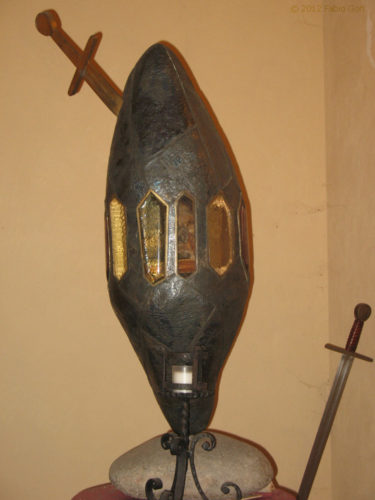
But Cristina goes on to inform us that the skull of San Galgano is now contained in a reliquary in the San Michele church (Prepositura di San Michele Arcangelo) in Chiusdino. This evocative reliquary was created in 1977 by goldsmith Bino Bini. The modern reliquary is made in embossed silver designed to recall the rock into which the saint thrusted his sword.
Cristina adds another touring note: There is a chapel attached to the Rotonda di Montesiepi with frescoes by Ambrogio Lorenzetti, painted in 1340 with scenes from San Galgano’s life. Lorenzetti was one one the greatest Sienese masters of Medieval art, the one responsible for the world famous Allegory of Good and Bad Government. The San Galgano frescoes were detached last year and moved to the Museum of the Santa Maria della Scala Hospital in Siena, across from the Duomo, where they are now being restored by the famed restauratore Massimo Gavazzi.
Find Cristina Amberti on Facebook and at SienaTours. Tuscan Traveler recommends that you take a tour with her to understand Siena and its history to the fullest.
